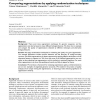Free Online Productivity Tools
i2Speak
i2Symbol
i2OCR
iTex2Img
iWeb2Print
iWeb2Shot
i2Type
iPdf2Split
iPdf2Merge
i2Bopomofo
i2Arabic
i2Style
i2Image
i2PDF
iLatex2Rtf
Sci2ools
BMCBI
2007
2007
Comparing segmentations by applying randomization techniques
Background: There exist many segmentation techniques for genomic sequences, and the segmentations can also be based on many different biological features. We show how to evaluate and compare the quality of segmentations obtained by different techniques and alternative biological features. Results: We apply randomization techniques for evaluating the quality of a given segmentation. Our example applications include isochore detection and the discovery of coding-noncoding structure. We obtain segmentations of relevant sequences by applying different techniques, and use alternative features to segment on. We show that some of the obtained segmentations are very similar to the underlying true segmentations, and this similarity is statistically significant. For some other segmentations, we show that equally good results are likely to appear by chance. Conclusion: We introduce a framework for evaluating segmentation quality, and demonstrate its use on two examples of segmental genomic struc...
| Added | 09 Dec 2010 |
| Updated | 09 Dec 2010 |
| Type | Journal |
| Year | 2007 |
| Where | BMCBI |
| Authors | Niina Haiminen, Heikki Mannila, Evimaria Terzi |
Comments (0)

